Images for the news release “Sarah Angelina Acland re-discovered as one of the pioneers of colour photography”.
© Bodleian Library, University of Oxford (monochrome images); Museum of the History of Science, Oxford (colour and images 10 and 12); Ashmolean Museum, Oxford (image 2, WA.RS.UF.44c); and Giles Hudson
Image 1
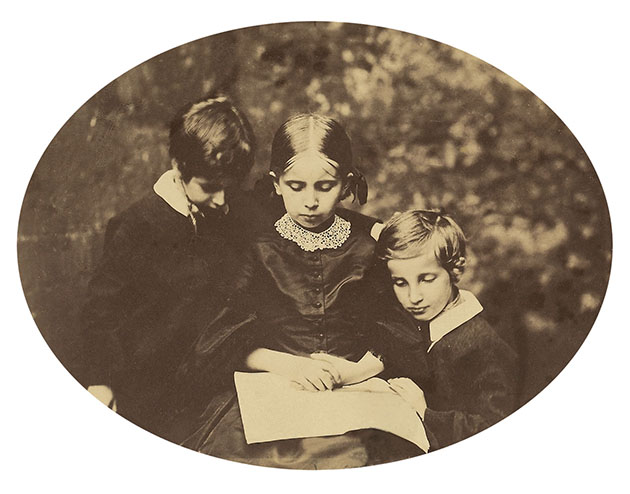
Sarah Angelina Acland, aged 7, with her brothers Theodore and Henry, photographed by Charles Lutwidge Dodgson (Lewis Carroll) in 1856
Sarah Angelina Acland was the daughter of Henry Wentworth Acland, Regius Professor of Medicine at Oxford. She and her brothers were the closest childhood friends of Alice Liddell and her sisters Ina and Edith. Like the Liddell sisters the Acland children were taken on rowing trips on the River Thames by Lewis Carroll who told them stories “bits of which became Alice in Wonderland”.
Having been photographed by Lewis Carroll as a child, as an adult Miss Acland took up photography herself. Her most important contribution to the field was as a colour photographer using the “Sanger Shepherd process of natural colour photography”. In the conventional account of the history of photography “the birth of colour photography” is said to have taken place in June 1907 with the release in Paris of the “Autochrome” process by the Lumière brothers. However, Miss Acland began experimenting in colour photography in 1899. In 1905 and 1906 she gave four lectures on the subject at the Royal Photographic Society in front of overflowing audiences. Her colour lantern slides were regarded as the finest that had ever been seen by her contemporaries, who credited her with inaugurating the field of colour photography “as a process for the travelling amateur”.
Image 2
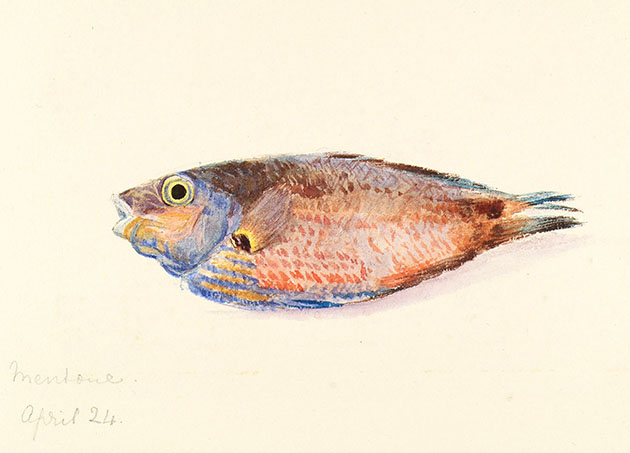
Watercolour study of a fish by Miss Acland, made in Mentone on the French Riviera in 1877
Before turning to photography Miss Acland was an enthusiastic artist in watercolours. She studied at the Oxford School of Science and Art (now Oxford Brookes University) before taking private lessons from John Ruskin. Ruskin, who had been an undergraduate friend of her father, lodged with the Aclands during his first course of lectures as Slade Professor of Fine Arts at Oxford, when she developed a close friendship with him.
Image 3a & 3b
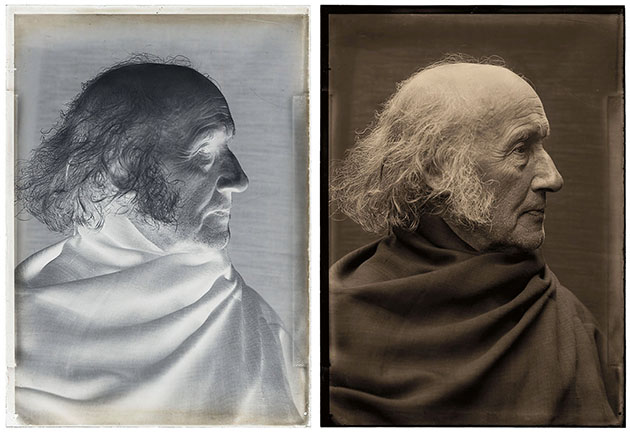
Miss Acland’s father, Henry Wentworth Acland, Regius Professor of Medicine at Oxford, 1892
During the time Ruskin was staying with the Aclands the famous photographic portraitist Julia Margaret Cameron visited them. Critic and photographer came to blows over the merits of photography in the Acland drawing room, Miss Acland recording in her memoirs how Cameron had exclaimed “John Ruskin you are not worthy of photographs”.
When Miss Acland took up photography in 1891 portraiture was the first genre in which she chose to specialize. In their strong contrasts of lighting and use of diffusion of focus her earliest portraits owe a strong debt of influence to Cameron, as did the work of many women photographers in the 1880s and 1890s.
Image 4

Broad Street, Oxford, with the Acland house (second from right) and Clarendon Building, 1892
Miss Acland lived in a large house in the centre of Oxford, directly opposite the Sheldonian Theatre and Clarendon Building (the large portico on the left). The house was a busy meeting place for men and women of influence connected with the university and city. After her mother’s death in 1878 Miss Acland, aged 29, took over the running of the house for her father until his death in 1900. Due to a childhood illness she suffered from weakness in her legs that confined her to a wheelchair for lengthy periods. When he fell ill as an undergraduate at Oxford Prince Leopold borrowed her chair.
The Acland house and the other buildings on the right in this photograph were demolished in the 1930s to make way for Giles Gilbert Scott’s new building for the Bodleian Library, now known as the Weston Library.
Image 5a & 5b
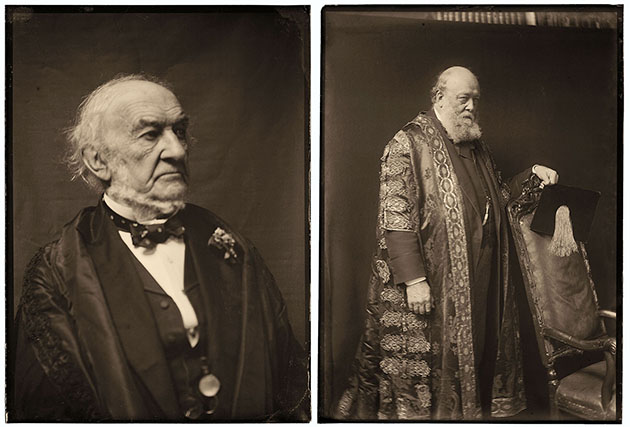
Prime Ministers W. E. Gladstone (left) and Lord Salisbury (right), 1892 and 1894
Miss Acland’s earliest public success came with a portrait of the Prime Minister, W. E. Gladstone. She photographed Gladstone in a studio at the back of her house, after he had given the first Romanes Lecture. Two years later she photographed the Conservative Prime Minister, Lord Salisbury, during a meeting of the British Association for the Advancement of Science. Both men were long-standing friends of the family.
Image 6a & 6b
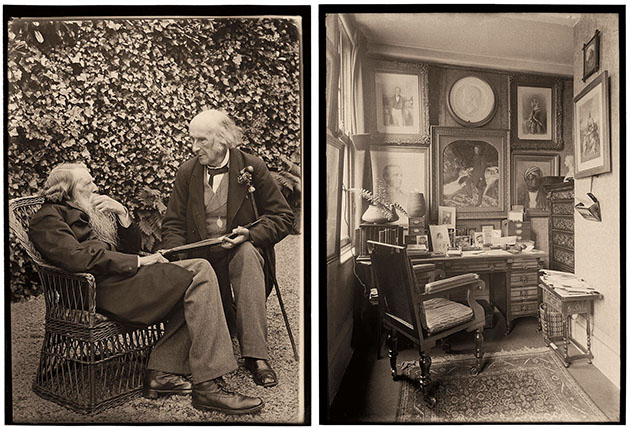
Ruskin and Acland at Brantwood, 1893; Millais’s portrait of Ruskin at Glenfinlas, hanging above Miss Acland’s writing desk, 1900
The two great passions of Miss Acland’s father, which he instilled in his daughter by example, were art and science. Acland was the driving force behind the building of a new museum in Oxford, now the Oxford University Museum of Natural History, on which he collaborated closely with Ruskin. A patron and physician of the Pre-Raphaelites, his home was hung from floor to ceiling with modern works of art by Millais, Rossetti, Burne Jones, Turner, the sculptor Alexander Munro and other famous arists. In Scotland in 1853 he held the canvass as Millais began one of the most celebrated paintings of the 19th century: his portrait of Ruskin at Glenfinlas. The portrait hung above Miss Acland’s desk, commemorating her friendship with the critic.
Image 7a & 7b

Mary Trinder Barney and Domenico Guastelli, circa 1895
Members of all classes sat to Miss Acland for their portraits, not just celebrities. Mary Barney was the widow of an Oxford chimney sweep, Domenico Guastelli a hawker of plaster casts of busts of Beethoven, Bach and other famous personalities.
Image 8
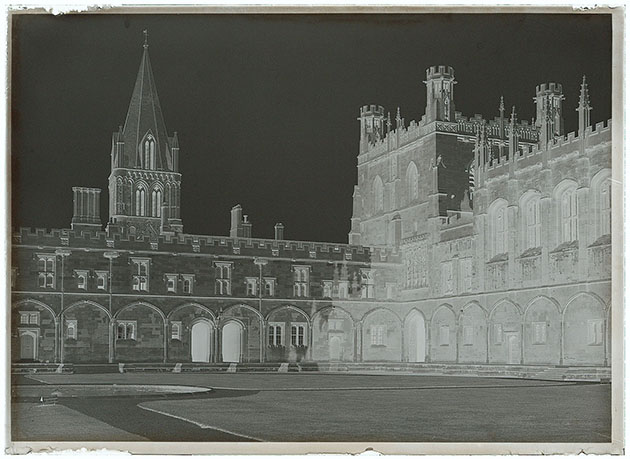
Christ Church, Oxford, with the cathedral tower and bell tower, 1899
In 1894 Miss Acland joined the recently-founded Oxford Camera Club as its first lady member. She would soon become one of its leading photographers, serving as Vice President for many years. As well as being a forum in which women could partake on more equal terms with men than in other areas of Victorian life, the Camera Club had a strong collective identity and collaborative ethos. In 1897 it embarked on a joint project to photograph the Oxford colleges, in order to provide illustrations for a series of histories commissioned by the London publisher F. E. Robinson. Miss Acland was allocated Christ Church, the college which her father, Dean Liddell, Ruskin and Lewis Carroll had all attended.
Image 9
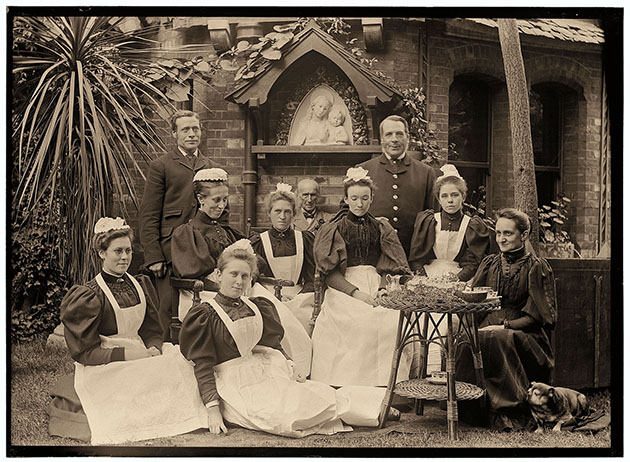
The Acland servants, circa 1897
During the 1890s Miss Acland lived alone with her father, looked after by eight servants and a nurse. The household posed for a group portrait in the garden, in front of a Della Robbia Virgin and Child given to her by Ruskin in 1878.
Image 10a & 10b

“Little Milkman and Little Milkmaid We”, 1896; Eagle Owl chicks, 1904
Miss Acland was interested in many different branches of photography. Child portraiture and animal studies were particular favourites. “Little Milkman and Little Milkmaid We”, which depicted her niece and nephew, is an example of a “genre study”: a picture that “tells a story or expresses a sentiment”. The photographs above are both glass lantern slides, 3¼ inches square: the most common format of photography in the late Victorian period.
Image 11a & 11b
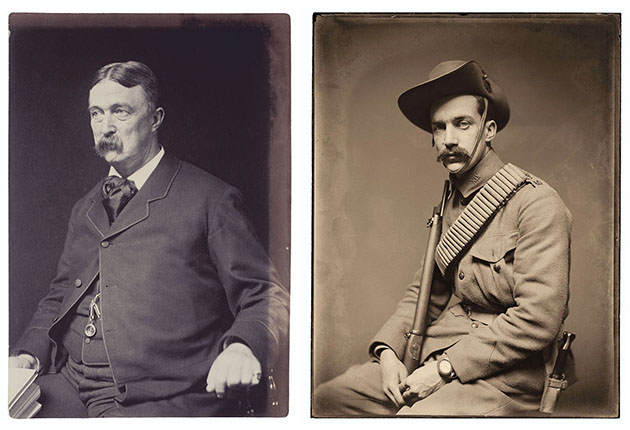
John Shaw Billings, 1894; ‘Trooper’ Sidney Peel, 1900
Men and women from near and far visited Miss Acland’s home studio to have their portrait taken. John Shaw Billings was the first Director of the New York Public Libraries and the designer of the Johns Hopkins Hospital in Baltimore. Sidney Peel was the grandson of Prime Minister Robert Peel. In 1899 he joined the Oxfordshire Company of the Imperial Yeomanry, going out to South Africa to fight in the Boer War and writing a popular memoir of his experiences on his return.
Image 12
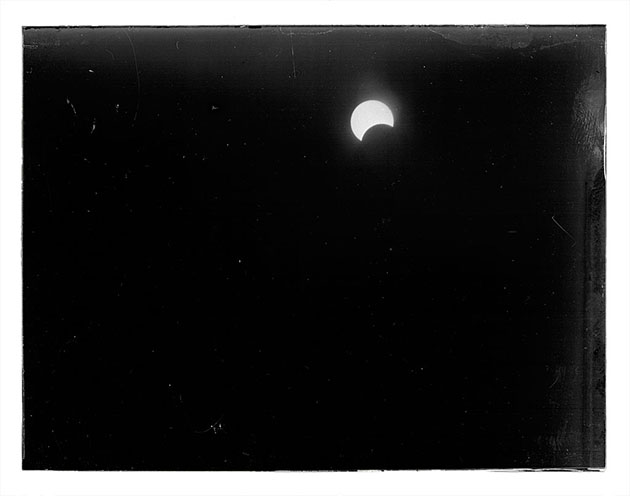
Partial eclipse of the sun, April 1921
Miss Acland’s photography was a manifestation of her wider artistic and scientific interests, the professional pursuit of which was largely closed to her as a middle-class Victorian woman. As well as becoming a fellow of the Royal Photographic Society she held fellowships at the Society of Arts and Royal Meteorological Society.
Image 13a & 13b

“Crimson Rambler in New College Garden”; Virgin and Child after Luca Della Robbia; Sanger Shepherd process colour photographs, 1900
In 1900 Miss Acland largely gave up monochrome work in order to devote herself to colour photography with the “Sanger Shepherd process”. These are among her earliest colour photographs. They were taken seven years before the release of the Autochrome, pointing to the fact that the English rather than the French process should be credited as the first practicable, commercially-successful process of colour photography.
Miss Acland exhibited these photographs both as colour prints on paper and as colour lantern slides on glass for showing through a projector. Today most of her photographs survive only as three-colour separation negatives, from which these images have been digitally recomposed.
Image 14
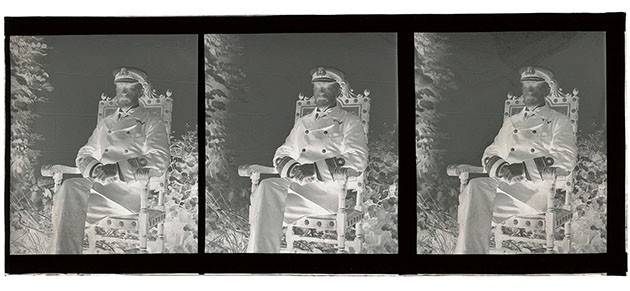
Sanger Shepherd three-colour negative, 1903
In the Sanger Shepherd process of “natural colour photography” three separate black and white negatives were taken one after another through red, green and blue filters. Positives from these ‘separation negatives’ were then printed as a blue cyanotype on glass and as magenta and yellow carbon prints on celluloid (in which the image is formed by the action of light in hardening a thin layer of gelatine which is then stained with dyes). The three transparent prints were then superimposed to create the final colour image. The total exposure for the negatives was usually about two minutes in bright sunlight outdoors, the red plate requiring the bulk of the time, since photographic plates were least sensitive to red light (hence the colour of the darkroom safelight).
Image 15
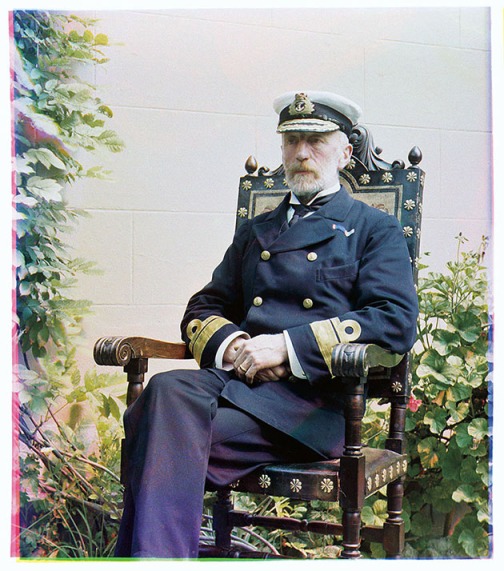
William Alison Dyke Acland, Sanger Shepherd process, 1903
One of Miss Acland’s most successful early colour photographs was a portrait of her brother, William Allison Dyke Acland. Willie was an Admiral Superintendent of the dockyard in Gibraltar, having previously served as ADC to Queen Victoria.
Creating colour lantern slides with the Sanger Shepherd process was a technically demanding and time consuming process, but one to which women were regarded as being particularly well-suited due to their patience, cleanliness and tidiness.
Image 16
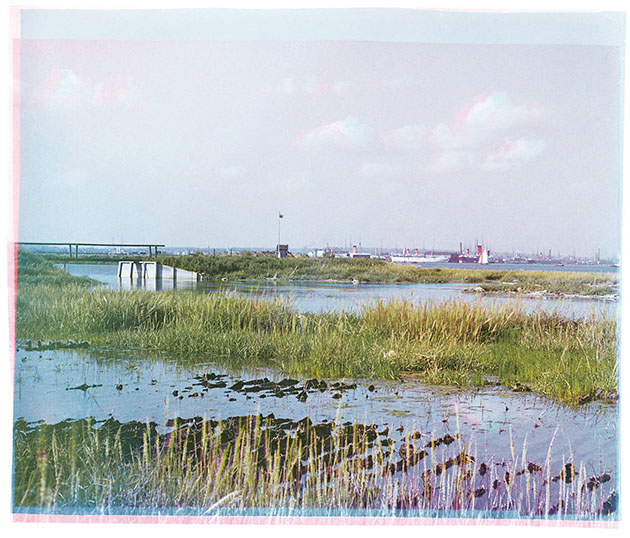
Foreshore, Southampton Water, and the Docks, from Hythe, Sanger Shepherd process, 1902
Urban scenes are rare among Miss Acland surviving photographs, as she preferred more conventionally picturesque subjects. Here, however, the Port of Southampton is visible in the distance, busy with troopships and transports involved in the Boer War supply.
Image 17
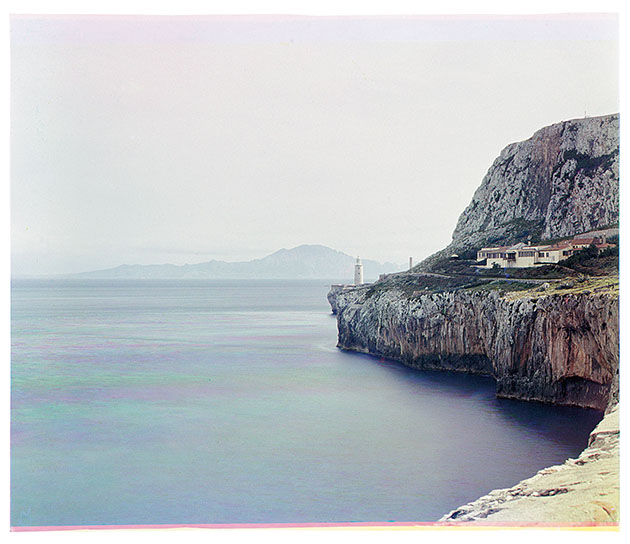
The Coast of Morocco from the Europa Advance Battery, Gibraltar, Sanger Shepherd process, 1903
The colour photographs that brought Miss Acland to fame were taken in Gibraltar in 1903 and 1904, during a visit to her brother. While the general public admired the bright colours in her colour slides, the photographic cognoscenti were more impressed by her skill in rendering neutral tones, which was considered a greater challenge in early colour photography. The colour fringes visible in the sea in this image were caused by the movement of the waves during the three long exposures. The building is Governor’s Cottage, a summer retreat on the shaded east side of the Rock of Gibraltar.
Image 18
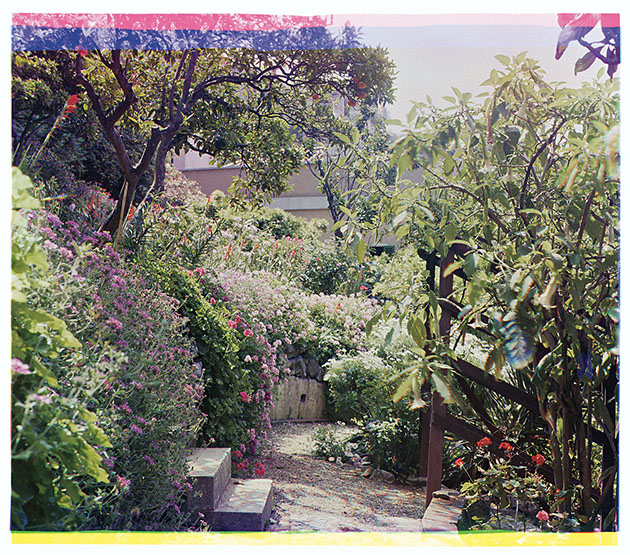
“Solomon’s Gardens of Old”, Gibraltar, Sanger Shepherd process, 1903 or 1904
Many of Miss Acland colour photographs in Gibraltar were taken in the garden of “The Mount”, the Admiral’s official residence. The garden was arranged on steep terraces clinging to the west side of the Rock. Miss Acland was captivated by the vibrant colours of the Gibraltar flora and the possibility that they could be captured by photography for the first time.
Image 19a & 19b
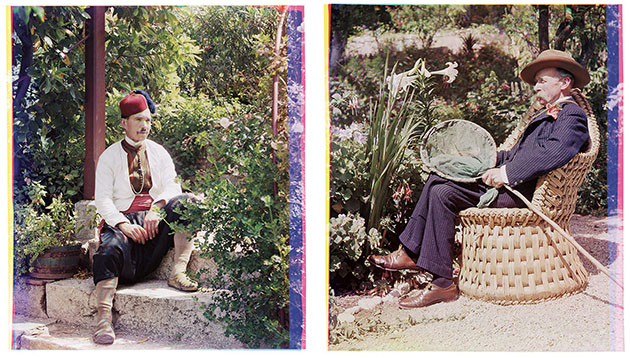
“Conda the Moor” and Colonel Willoughby Verner, Sanger Shepherd process, 1903
In Gibraltar Miss Acland photographed both the local people and visitors. Conda was a gardener at the Mount, Colonel Verner an officer in the Rifle Brigade who had taken up ornithological photography in his retirement.
Miss Acland is now less well known as a colour photographer than her immediate successors, such as Sergei Prokudin Gorskii and Albert Kahn. However, the startling quality of her achievements before 1907 requires conventional assumptions about the history of colour photography to be reassessed.
Image 20
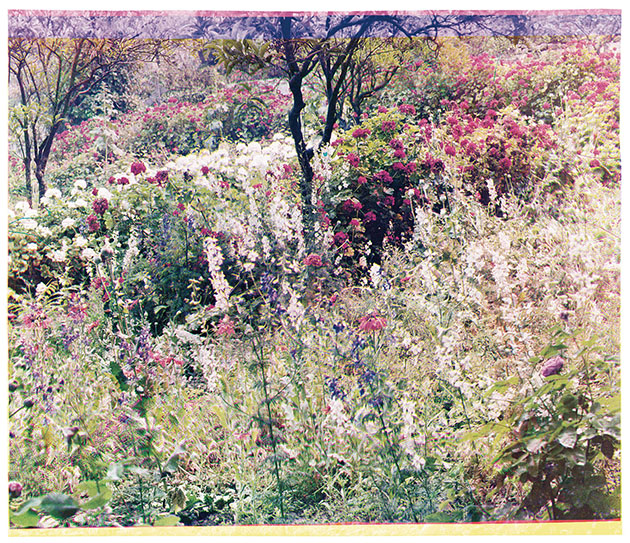
Gibraltar flora, Sanger Shepherd process, 1903 or 1904
Miss Acland’s colour photographs were contemporaneous with Claude Monet’s paintings of Giverny and share a preoccupation with light and colour over composition and form.
Image 21
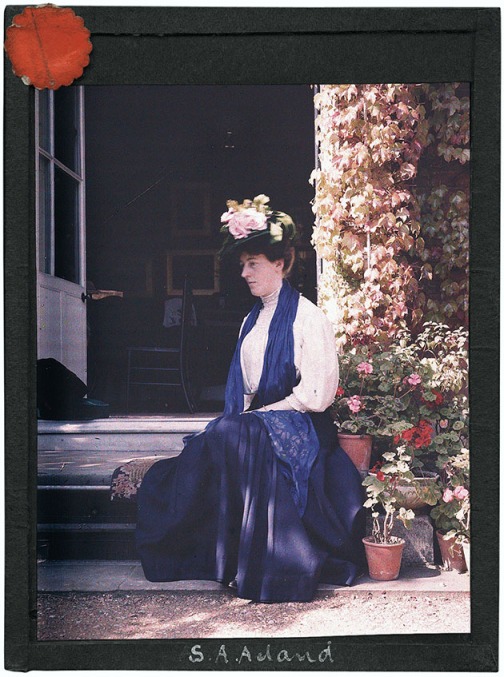
Portrait of Margaret Hope, Autochrome, September 1907
Having already established herself as the leading colour photographer of the day, in September 1907 Miss Acland began experimenting with the Lumière brothers’ revolutionary new Autochrome process. With the Autochrome a colour photograph could be taken in a single exposure on a single plate. Somewhat astonishingly, the colour in the image was create by a microscopic screen of potato starch grains, dyed red, green and violet.
Miss Acland submitted this plate to the Society of Colour Photographers first annual exhibition in October 1907, making it the earliest Autochrome by a woman to be exhibited in public. Maggie Hope was the former ward of her aunt Agnes Cotton, who ran an industrial school in Leytonstone for the training of girls rescued from prostitution and other vice.
Image 22
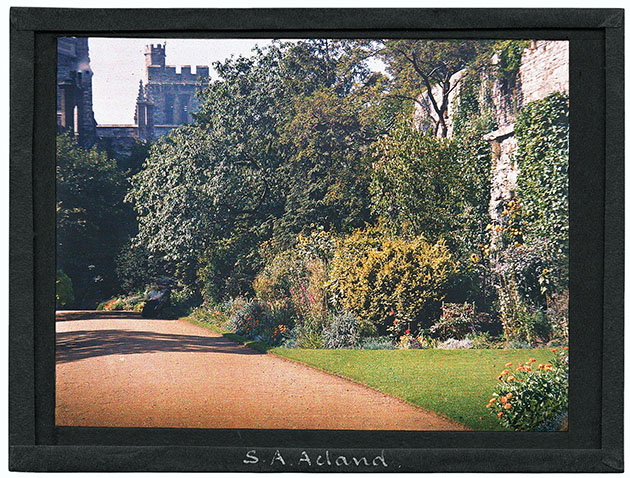
“Autumn Colours in New College Gardens”, Oxford, September 1907
The rich, dense colours of the Autochrome caused great excitement when the process was first released. This scene remains almost unchanged today but has rarely been captured so effectively by photography.
Image 23
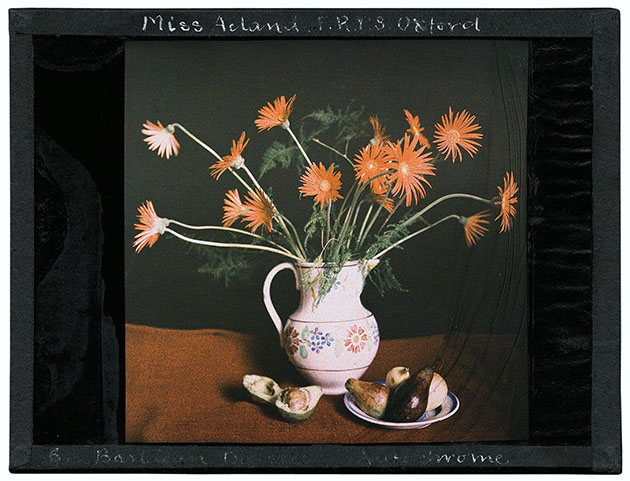
Still life with Barberton Daisies and avocadoes, Autochrome, circa 1910
Barberton daisies are native to South Africa and the hills surrounding the town of the name in what is now Mpumalanga province, formerly Eastern Transvaal. The plant only came into common cultivation in Europe after 1900, making the blooms still something of a novelty, and a colourful one, when photographed by Miss Acland.
Image 24
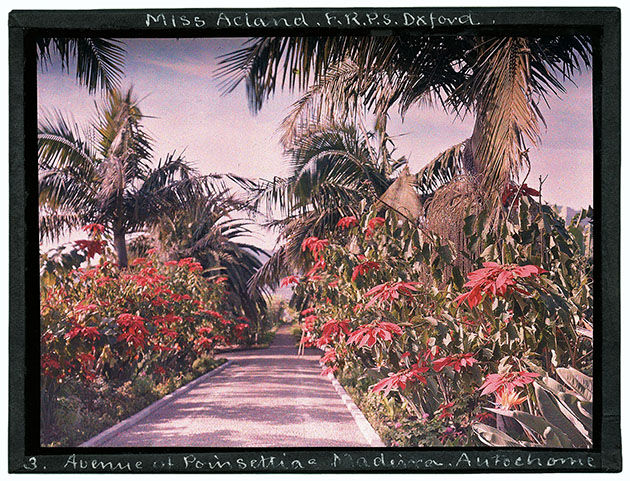
The Avenue of Poinsettias, Funchal, Madeira, circa 1909
Much of Miss Acland’s work with the Autochrome process was undertaken on the island of Madeira, where she travelled for six months every winter for the benefit of her health. The gardens in Funchal were a feast of colour and the light good, making for ideal conditions in which to experiment in colour photography.
Image 25a & 25b
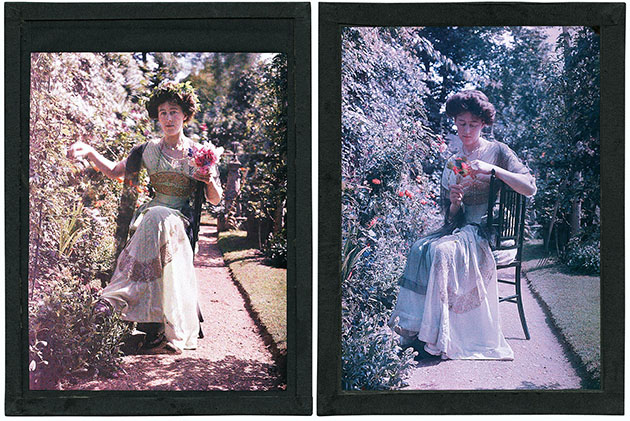
Margaret Hope, photographed on an Autochrome plate (left) and an Omnicolore plate (right), circa 1909
After mastering the Autochrome Miss Acland experimented with a number of rival ‘screen-plate’ processes. The Omnicolore process was based on a similar principle to the Lumière plates, but rather than a random pattern of potato starch grains it relied on a geometrical screen of red, green and blue lines, analogous to the television or computer monitor of today. The colour harmonies produced by the Autochrome and Omnicolore were quite different, the former characterised by warm pinks, the latter cool blues.
Image 26a & 26b
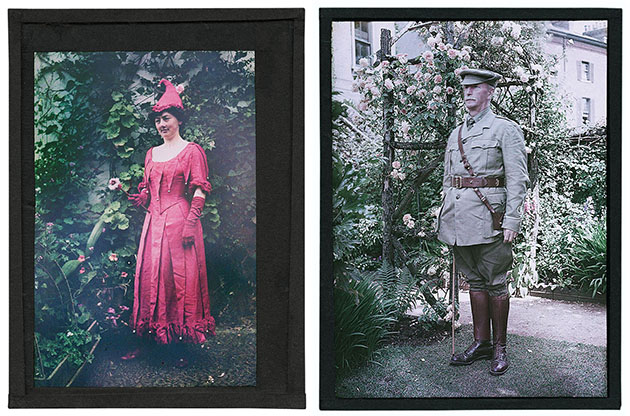
A woman dressed as a jester, Dufay Dioptichrome plate, circa 1911; Henry Dyke Acland in army uniform, Paget Colour plate, circa 1917
The Dufay Dioptochrome was a French alternative to the Autochrome. Unreliable, it was little practised, although here Miss Acland had managed to obtain a successful portrait of one of her maids. The Paget Colour process was the first successful screen-plate of English manufacture. Despite its strong green bias Miss Acland came to prefer it over the Autochrome, especially because it required shorter exposure times: fractions of a second in good lighting conditions, compared to a second or more with the Lumière plates.
Miss Acland’s brother Harry lived in Great Malvern, where he was Edward Elgar’s bank manager and golfing partner. After his retirement he joined the army as a musketry instructor. The strain of the First World War led Miss Acland to give up most of her photography in 1919, at the age of 70.
Image 27a & 27b
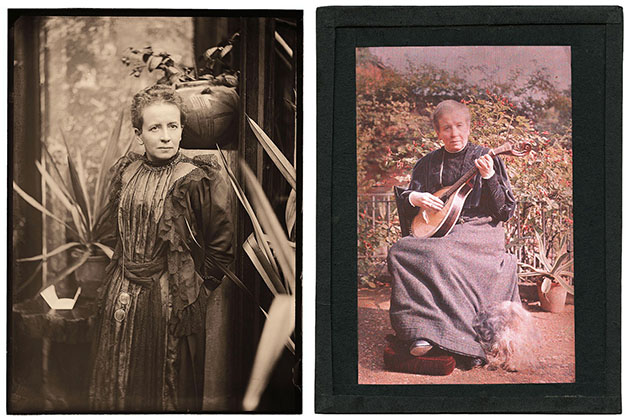
Self portraits by Miss Acland taken in 1894 and 1910, on a gelatine negative and Autochrome plate
Miss Acland photographed herself in black and white aged 45 and in colour in her 60s. She is wearing unusually artistic dress, reflecting the creative independence she gained through photography.
Although she was largely forgotten after her death in 1930, the significance of Miss Acland’s contribution to photography is difficult to overstate. She was the first photographer to create a substantial body of colour work outside the studio and the first to demonstrate that colour photography was a viable goal for the amateur. Her colour slides of Gibraltar in particular were the prototype of all subsequent attempts to record the world in colour, whether by her immediate successors or the myriad photographers who contribute to the global digital projects of today.
Image 28
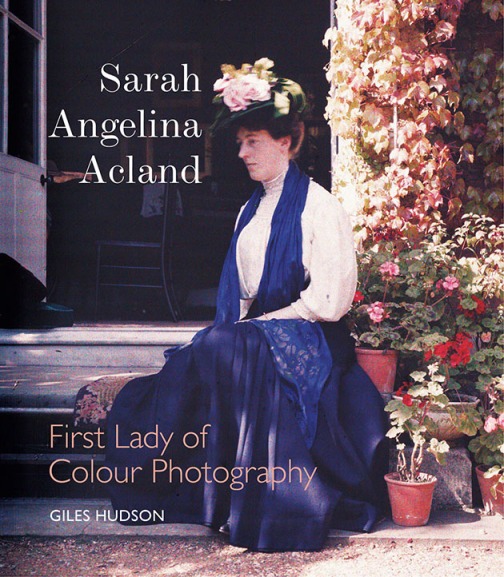
Sarah Angelina Acland: First Lady of Colour Photography is published by the Bodleian Library. It reproduced more than 220 examples of Miss Acland’s work from over 1,000 surviving photographs in the University collections of the Bodleian and Museum of the History of Science, Oxford.



























